Sapphire Radeon HD 3870 512MB GDDR4 Review
Sapphire Radeon HD 3870 512MB GDDR4
AMD returns to the graphics fold with the ATI Radeon HD 3870. Is it a comeback kid or will ATI be riding off into the sunset.
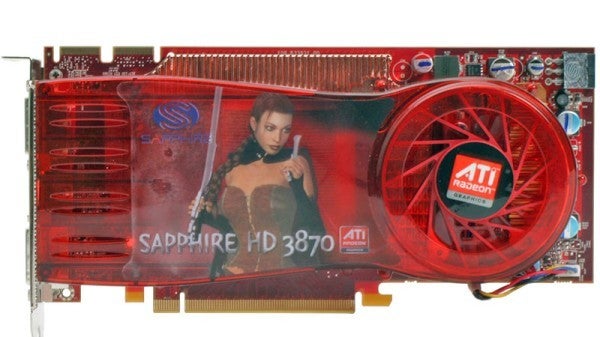
Verdict
Key Specifications
- Review Price: £139.98
Over the past few months nVidia has had it pretty easy. While AMD has been slowly trying to digest ATI and looking in horror at how little change it has left in the kitty, it hasn’t produced much in the way of competition for the big green giant.
While we all waited with bated breath for R600, nVidia released the big, brutal and rather overwrought GeForce 8800 GTX Ultra as a pre-emptive spoiler, only to find that it really needn’t have bothered. Even in its fastest guise – the ATI Radeon HD 2900 XT, R600 was only aimed at nVidia’s second tier GeForce 8800 GTS and not the GTX. More recently, nVidia has wowed us all again with the release of its 8800 GT, which has simply taken the market by storm – delivering a large slice of the power of an 8800 GTX card, in a single slot solution, for less cash. What’s not to love?
It’s into this rather hostile market that ATI is pitching its new RV670. Can it make an impact? Well, once again ATI hasn’t gone for the jugular, as the card still isn’t aimed at toppling nVidia’s 8800 GTX, but is instead intended just to replace it’s own the 2900 series, delivering round about the same performance but at lower cost and drawing less power. Instead of playing fast, it’s trying to play it smart and on that basis RV670 is again a contender.
There are two cards available in the series – the Radeon HD 3850 and the Radeon HD 3870. The standard 3870 has a core clock of 775MHz and 512MB of 2.25GHz GDDR4 memory. 
The former is a single slot card retailing for just over £100, while the more powerful Radeon HD 3870 is a dual-slot card that will set you back around £140, which is around £35 less than a 512MB standard clocked GeForce 8800 GT. All in all, it’s a competitive market once again, which is good to see. A small problem though is that despite AMD telling everyone that the yield on these new cards would be fantastic, as of writing it has still to appear on the shelves as an in stock product, though most stores claimed it is days away.
”’New Generation, New Naming Convention”’
For the 3800 series AMD has tweaked its naming convention removing the XT, Pro, XTX, TTX, and X$RTGTR and all that gubbins. Now the first number reflects the generation, the second the family, and the third the variant. Simple really.
We were told that the 50 was equal to Pro and the 70 equal to the old XT. So it should be easy to tell what card is faster than the other – it will just have a higher number. The card we ran through our benchmarks was a Sapphire card, and on at least one site I saw the XT’s and the Pro’s had been tacked onto the name, which is actually incorrect.
”’New Micron Process”’
AMD has made a lot of the fact that its new ‘Spider’ platform, consisting of CPU, chipset and graphics was a smart and efficient design – hence it’s ‘Smart Choice’ tag line for the Spider launch. The new 3850 and 3870 definitely play their part in this running cooler and therefore quieter than their previous incarnations and unlike the previous gen HD 2900s, they only require a single power connector.
The reason for this is that for the 3000 series AMD has moved to a 55nm manufacturing process. As we know, shrinking down the size of each transistor brings with it a number of benefits. You can fit more chips onto a wafer, so that once the manufacturing process has been perfected you can get more chips, thus increasing supply. This lowers costs and enables prices to come down. You can also fit more transistors into the same space, though with the RV670 AMD has actually gone down from 700 million to 666m, resulting in a die size of 192 sq.mm. 
It also means less heat and as you can see from the slide, it now has a power draw of 105W under full load, less than half of the HD Radeon 2900 XT. The end result is a cooler, quiet card to live with, which considering we should be looking at the same performance, is great. Both ATI and nVidia based graphics boards now feature generally quieter operation than previous generations, which is great to see, or rather hear.
”’Power Play”’
Staying with power efficiency, AMD has also introduced technology on its ATI GPU’s that’s similar to the Cool ‘n Quiet on its CPUs, but up till now has only appeared on its mobile chips. It’s called ATI PowerPlay for the Desktop. This introduces automatic power state adjustments depending on GPU activity, so under light usage parts of the GPU are shut down, so you’re not drawing lots of power that you aren’t using. Light gaming, essentially games that are CPU limited, (which is even the case for Source based games, like Team Fortress 2 and Half-Life 2: Episode 2, these days), will drop the power draw, while if you’re playing a recent title, the chip will give it the full beans. It’s a great idea and in this age of green issues, I’m amazed it’s taken so long. 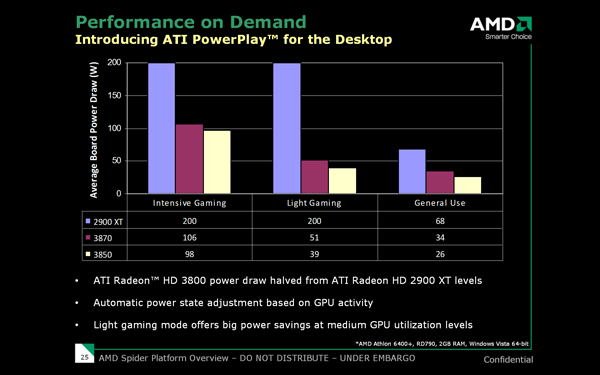
”’Architecture”’
The basic architecture of the new cards is essentially the same as that of R600 – the HD 2900, and it still features 320 stream processors, split into 5 clusters of 64. As before there are 16 texture units and 16 Render Output Units (ROPs), the final part of the architecture that places the pixels on the screen. The programmable Tessalator Unit, as introduced on R600 is also present. The card is also now PCI Express 2.0 compliant, which means it can transmit data between it and the CPU at twice the speed as PCI Express 1. However, this is a non-issue as no card yet pushes the boundaries of PCI Express 1.
New for the HD 3800 series is the presence of UVD – ATI’s Universal Decoder, which gives it full support for hardware decoding of all stages of video playback for HD DVD and Blu-ray. AMD makes much of the fact that UVD fully offloads decoding of the VC-1 codec while nVidia’s PureVideo HD does not, a potential problem seeing as a majority of HD DVDs are encoded with VC-1. However, VC-1 is a far less intensive codec so it really isn’t as much of an issue as AMD is making out, though at the same time, it is a difference that might matter to some. If you’re in the habit of doing other things with your system while watching your HD discs, for example encoding some other video material, then you’re going to want as much free CPU time as possible.
The big new feature of the card though is support for Direct X 10.1. It’s essentially Microsoft tidying up DX10 adding several features that should have been in the first cut but for time reasons didn’t make it.
DX10.1 brings several new things to the table, two of which are Global Illumination and Deferred Shading with Multi Sampled Anti-Aliasing (MSAA).
”’Global Illumination”’
Global Illumination is a more accurate and sophisticated way of lighting objects in a scene. Previously, light maps were used to give the impression of a lit scene, but this doesn’t give good results with dynamic objects and lights. The new method creates hundreds of cube maps in a scene, with small virtual boxes containing a sphere at the centre. Each cube map is a reference point from which you can calculate how light will interact with nearby objects. By creating a cube map array, you can create many reference points and therefore more accurate lighting. DX10.1 enables this to be done quickly and efficiently so it can be done in real time. 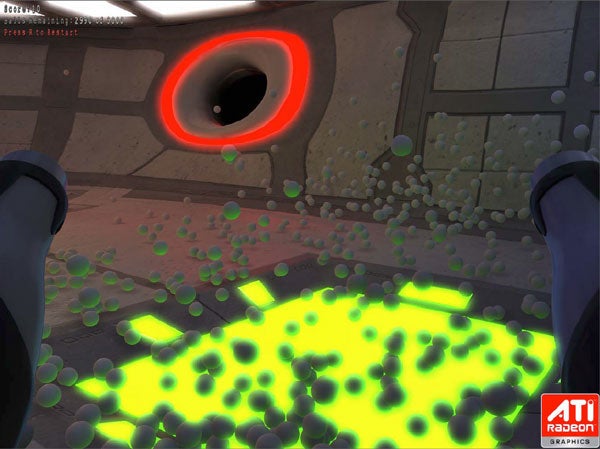
In an ATI demo, millions of small balls were correctly lit by multiple light sources, and reflected light accurately and even onto each other in real time. It’s a subtle effect but better lighting is one of the most important ways of making 3D scenes more realistic, so it is an important technique.
”’Deferred Shading with MSAA”’
Many games around now use a technique called Deferred Rendering. This is where geometry in a scene is stored as a texture in a G-buffer and then rendering is done on this. This is an efficient way of performing effects, particularly lighting, with the advantage that you don’t have to light pixels that aren’t actually going to be seen on screen.
Essentially, it effectively increases bandwidth in the graphics chip enabling more complex effects to be applied more efficiently. The problem is that it’s not possible to apply Multi-Sampled Anti-aliasing to effects done this way. It theoretically is possible using Supersampling, but the performance overhead is so great that the driver won’t let you use it. DX10.1 solves this problem by enabling multiple fetches from the G-buffer. The benefit to the user is deferred rendering with MSAA, so we can get great effects and improved image quality at the same time.
Additionally, in DX10.1, 4x Multi-Sampled Anti-Aliasing is now required on all compliant hardware. This is great as decent performing MSAA will be made available at a lower base line level.
To get these features you need specific new hardware, which gives AMD something to bash nVidia over the head since despite it’s dominance in performance, it has yet to add DX10.1 support to any of its cards.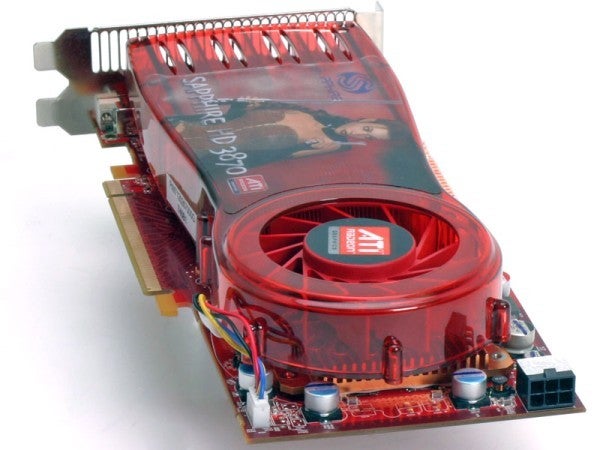
A similar situation occurred when nVidia had Shader Model 3 support on its 6800 and 6600 card, while ATI only had Shader Model 2 on X800. Now there are games out there that require Shader Model 3, but that’s unlikely to be the case for DX10.1 for a while, as developers have been quite vocal in stating that it isn’t seen as something crucial for them, which is a shame as it does bring some cool things to the table.
However, by the time games that take advantage of DX10.1 hit the market this card is likely to be quite dated so I wouldn’t recommend basing any purchasing decision on this feature. If it is an issue then perhaps you should hold off as rumour has it, and let me stress that this is rumour, that nVidia’s next gen card will appear in a couple of months and will offer DX10.1.
”’CrossFire X”’
With the new architecture AMD has also promised that the card will support up to four cards in a format called CrossFire X. This will be limited to working just with the Spider platform, so you’ll need a 790FX chipset and AMD CPU to get it to work. Driver support is promised in January so we can look forward to seeing it in action then.
On every card you’ll find two dual-link DVI connectors, so you can hook up to two 30in monitors and HDCP support is built-in to every card so there won’t be any problems watching your high def discs, especially with UVD on board.
In the box with this Sapphire card you get your installation CD, and OEM version of Cyberlink Power DVD, Cyberlink DVD Suite, a manual and a voucher for a free copy of ‘The Black Box’, (available only via Steam), which consists of Half-Life 2: Episode 2, Team Fortress 2 and Portal – each of which is quite simply superb – so thumbs up Sapphire. You also get a copy of 3DMark 06. Why not install this before removing your old graphics card and running it, so you can get some pleasing before and after numbers, which should put a smile on your face.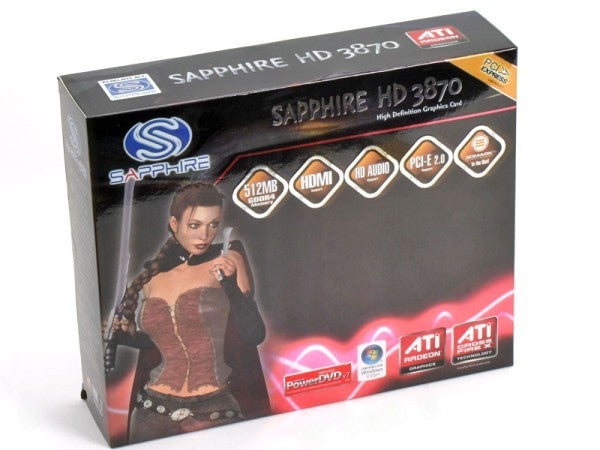
Cable wise you get a component cable, a 6-pin PCI Express power adaptor, a DVI to VGA cable, a TV out to composite connector and a CrossFire cable. You also get an ATI branded DVI to HDMI connector. If you want to get proper surround sound out of your card when watching HD movies you must use this, as ATI cards carry the digital audio over the chip and out as there is a audio chip built-in. With nVidia you need an external cable from card to the motherboard, which isn’t as elegant.
”’Testing”’
Our older game tests of Call of Duty 2 and Counter-Strike: Source were joined by Enemy Territory: Quake Wars and Crysis. As per usual, each game is run with full in-game detail settings at a variety of resolutions with varying degrees of anti-aliasing and anisotropic filtering applied. For all but Crysis, each setting is run three times and the average is taken so we end up with a pretty rock solid figure. 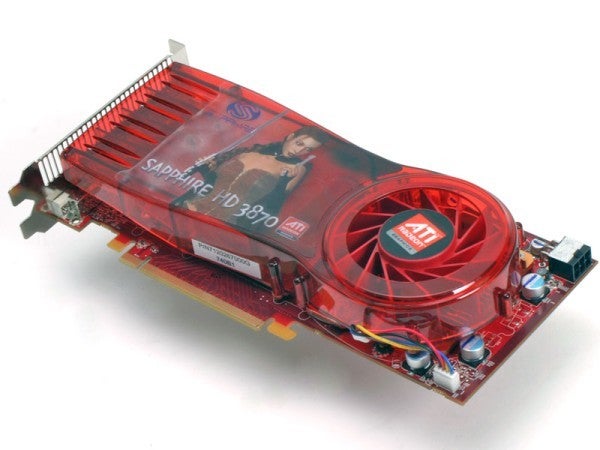
For Crysis we’ve used the inbuilt time demo that loops four times enabling us to calculate an average from the results. As it’s such a demanding game, though, we’ve kept in-game settings to high (rather than very-high) and also stuck to resolutions of just 1,280 x 1,024 and 1,680 x 1,050. We also use transparency anti-aliasing throughout our testing as we feel it’s a processing technique that greatly enhances image quality in a lot of games.
We generally find that any single card configuration struggles to cope at the resolutions demanded by a 30in monitor so we’ve stuck to testing at 1,920 x 1,200 and 1,600 x 1,200 (or 1,680 x 1,050), and 1,280 x 1,024 for these tests. We will, however, come back to test SLI and CrossFire configurations very soon so we will take a look at performance at 2,560 x 1,600 then.
Looking at the results you can see that the HD 3870 does indeed keep up with the older 2900 XT. Considering that the 2900 XT was launched at around £270, compared to less than £140 for the HD 3870, and AMD’s claims of performance and efficiency and low cost can be seen to be a resounding success
Unfortunately, what the HD 3870 can’t compete with in most cases is a GeForce 8800 GT, especially once the resolution and the anti aliasing and anisotropic filtering are applied. Take Call of Duty 2 at 1,920 x 1,200 – the 3870 gets 39.11fps versus 51.1 for the GT. Note these are stock 8800 GT scores – overclocked versions are available though of course they are priced accordingly.
However, ATI cards have always been great at Source engine based games, and at 1,680 x 1,050 at 4xAA and 8xAF, the 3870 is faster than the 8800 GT by a hefty 15fps and by almost as much at 1,920 x 1,200.
In Enemy Territory, the cards scale more linearly and the GT is always comfortably in front. In Crysis, all the single cards tested here struggle to achieve 30fps. From our experience you can get by at 25fps – the 3870 only manages this at 1,280 x 1,024. If you have a widescreen 1,680 x 1,050 screen, it drops below the threshold to 20.7fps, while an 8800 GT can give you 27fps. To my mind, Crysis is a game that graphically is still ahead of its time, and personally I’m not going to play it until I’ve got next gen hardware. 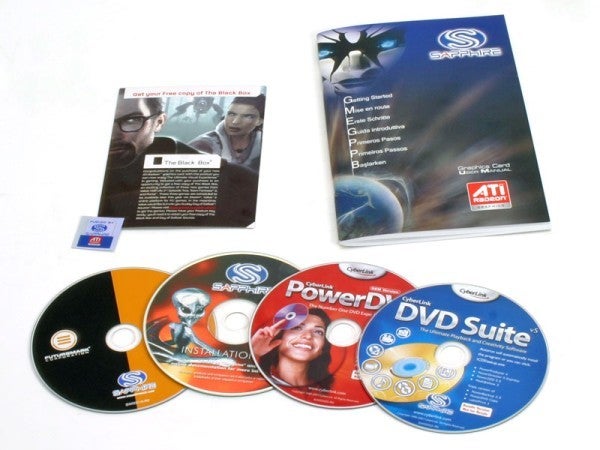
Clearly then, whether the Radeon HD 3870 is good enough depends on what games you play and at what resolution and settings. However, there’s no doubt that it delivers its money’s worth for performance. In Source it’s faster than an 8800 GT and in some games slower but it is at least £30 cheaper than a stock 8800 GT.
But is that enough? If you’ve got a small form factor system then the fact that the 8800 GT is single slot card might be enough to swing it in nVidia’s favour. With a single slot you then have a PCI slot free for things such as a dedicated sound card – which makes sense, especially if you’re gaming. However, if single slot is not an issue, then at the £140 mark, the £35-£40 saving over a GT actually translates into something concrete – such as a game or possibly two.
On that basis we’ll happily recommend the Sapphire HD Radeon 3870. We don’t think you’ll see much benefit from its DX10.1 feature set but for the sub-£150 gaming market it’s the card of choice. A good effort then, but we still want to see whether AMD can match or even beat nVidia at the high-end.
”’Verdict”’
This is something of a comeback for the ATI brand. AMD claimed the 3000 series would match the performance of the 2900s but be quieter, cooler and cheaper, and on that score it has achieved its aims admirably. No it isn’t as fast as an 8800 GT, but it’s priced accordingly, and for most games, certainly below 1,920 x 1,200, it’s fast enough.
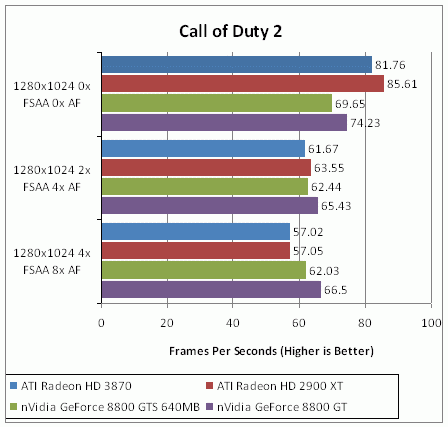
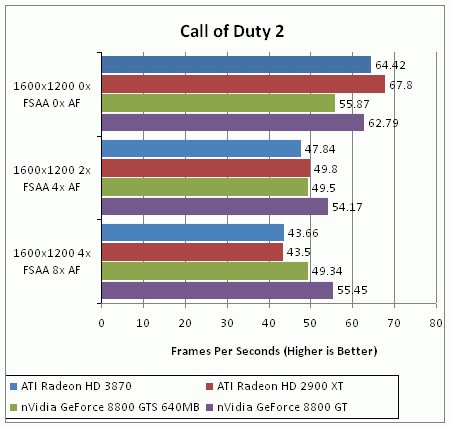
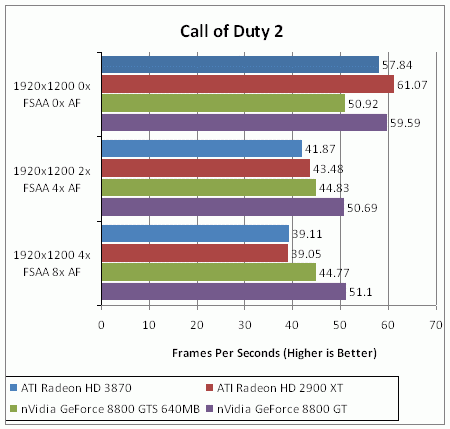
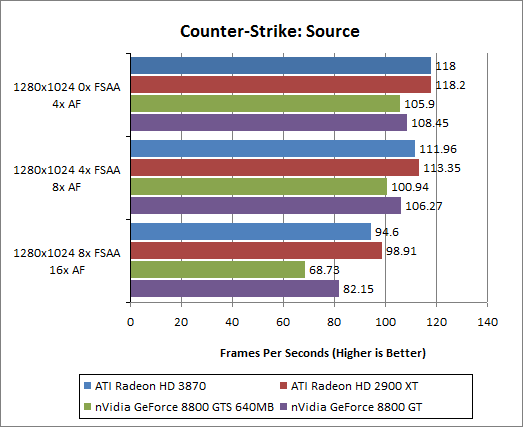
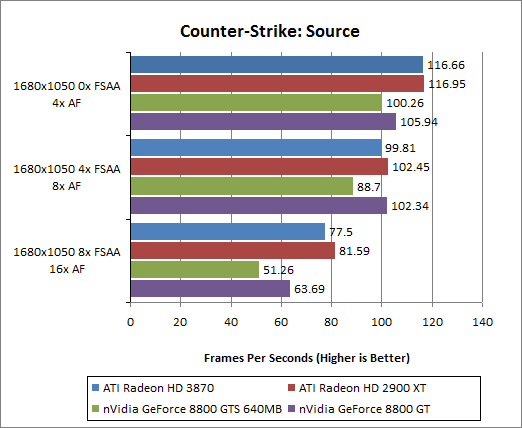
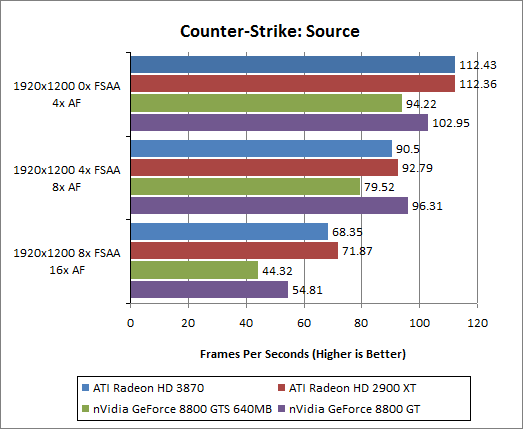
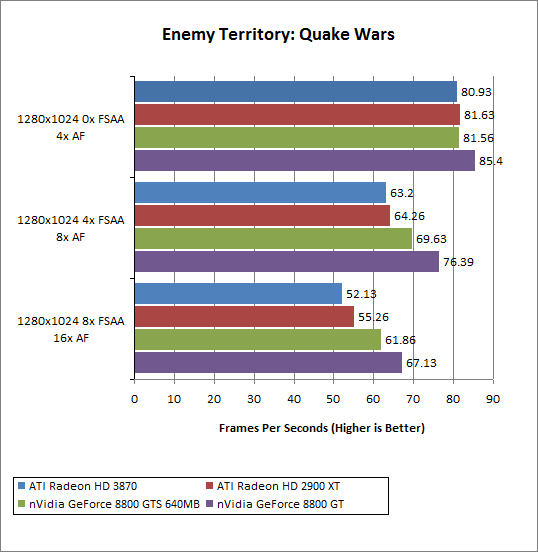
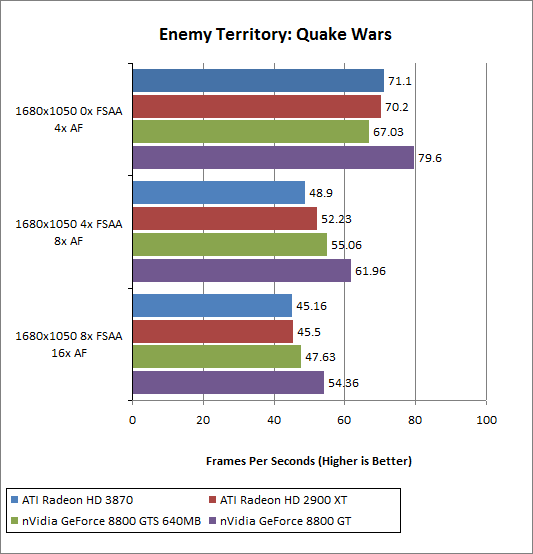
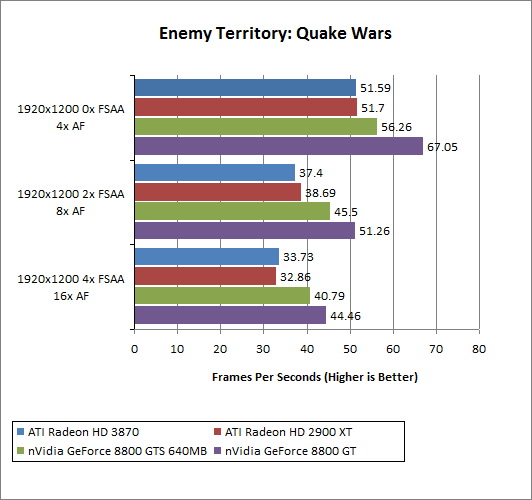
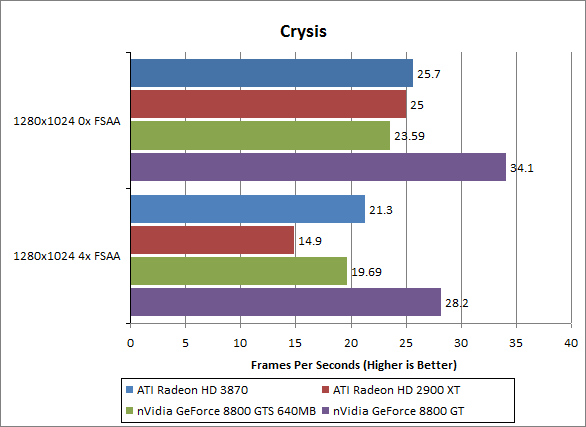
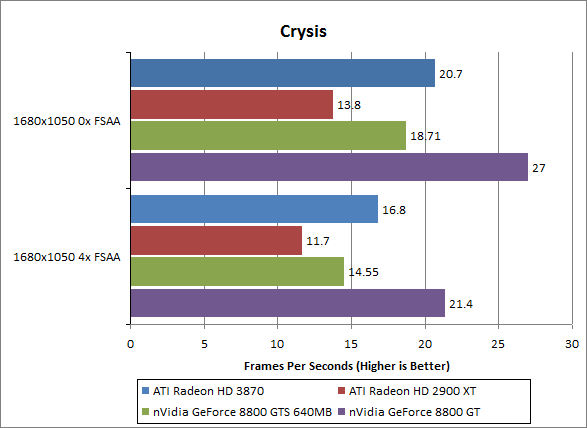
Trusted Score
Score in detail
-
Value 8
-
Features 9
-
Performance 8

